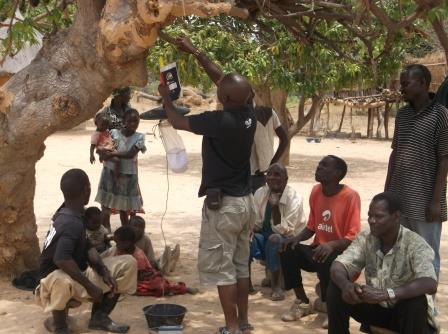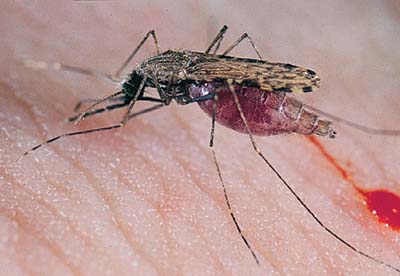
As a Malaria Control Program Officer and a Global Health Corps Fellow at PATH in Zambia, I conduct entomological surveillance of mosquito species. This has earned me the nicknames “Mosquito Chaser,” “Mosquito Hunter” and (the most hilarious) “Mosquito Whisperer” from my co-fellow Lis. But what exactly is entomology? Hence, what is entomological surveillance? What data is collected during these entomological surveys and what does it have to do with public health? In other words, why do I chase mosquitoes around?
Entomology is simply the study of insects. The word ‘surveillance’ has an interesting definition. According to the Concise Oxford Dictionary, it is “close observation, especially of an enemy or spy”.
Malaria entomological surveillance is hence the close observation of one of Africa’s greatest enemy, the vector that carries the parasite causing malaria, the female Anophelesmosquito.

Common tools in the fight against malaria include Insecticide Treated bed nets (ITNs) which act as a physical and chemical barrier between the mosquito and human hence preventing the malaria transmission cycle from mosquito to human. Another tool is Indoor Residual Spraying which involves coating walls and other surfaces of a house with a residual insecticide. For several months, the insecticide will kill mosquitoes and other insects that come in contact with these surfaces.
What data is collected during entomological surveys and why is this important in the fight against malaria?
1. Knowing the enemy and its size
Throughout the world, 528 species of anopheline mosquitoes have been discovered. Of these, less than 20 species present in Sub-Saharan Africa are able to transmit malaria to humans1. Five species, namely, Anopheles gambiae, Anopheles arabiensis, Anopheles funestus, Anopheles moucheti and Anopheles nili, are considered to be major malaria vectors as these are responsible for more than 95% of the total malaria transmission on the continent. The remaining five percent is transmitted by “secondary”, “potential” or “vectors of local importance1″. In Zambia, secondary or potential vectors include the species An. coustani, An. rufipes, and An. squamosus2. However, the so-called secondary malaria vectors, still play an important role locally, because they may contribute significantly to malaria transmission by increasing or extending the malaria transmission period1, 3.
With this background, entomological surveys help analysts to determine the exact species composition in any malaria prone area. Like in any war, it is important to know who your enemy is. It also important to know the size your enemy’s army. So we use entomological surveys to determine vector densities in any malaria-prone area. Places with high density mosquitoes may require different tactics to combat than those with fewer mosquitoes. For example, it will help us concentrate IRS activities in areas in of high mosquito densities as opposed to those of lower densities.
Another vital piece of any war is to know the war strategy your enemy is using. This brings us to the second piece of data collected during malaria entomological surveys: vector behavior.
2. Knowing the Enemies Strategy
If effective interventions are to be developed to reduce the risk of malaria transmission, it is important that the characteristics and behavior of each particular vector is closely observed. Entomological surveys help us to determine the feeding habits and density of the different mosquito species. Changes in behavior need to be identified quickly, so that interventions can be adapted accordingly. Changes in the biting and feeding behavior of mosquitoes can have a critical impact on how effective current interventions are. For example, if a particular species bites mostly during the early hours of the evening and tends to rest outdoors, that will compromise the effectiveness of insecticide treated nets. Similarly, if a species tends to rest outdoors after biting, then indoor residual spraying (IRS) will not be an effective control measure. Entomological surveys help us to design or adopt the most cost effective prevention and control strategies that are suited to local situations.
3. Age Profiling, Blood Feeding and Egg Development stages
Every mosquito collected is examined under a microscope to determine the blood feeding stage, which means they are checked whether it is fed, freshly fed, partly fed, or fully fed. During the collections, we determine the ratio of sleeping spaces to the number of nets a household has. Determining the blood feeding stages has two benefits: first, it reinforces our knowledge on vector behavior and secondly it gives us insight into the use of insecticide treated nets in any community, knowledge which is then passed on to the Communications, Behavioral Change and Advocacy team.
Mosquitoes collected during these studies are also checked for their gravidity (pregnancy) or egg developmental stage: fully gravid, half gravid or not gravid. Recall, mosquitoes need a blood meal to maturate their eggs before laying them. This data gives further insight on the biting rates and use of ITNs.
Unfed mosquitoes are sometimes dissected and their ovaries removed and tested to establish if they have laid eggs before. This is helpful because from that, we are able to determine the age profile of the enemy in a particular area. Determining the age is important because an older mosquito population gives an insight on how much risk exposure to mosquitoes a particular community have. The older the mosquito population is, the more dangerous it is because of their ability to transmit the malaria parasite. A younger mosquito population gives insight on the availability of breeding sites and tells a lot on the feeding/biting rates considering mosquitoes need a blood meal before laying eggs.
So now you know what happens when I am chasing mosquitoes. In my next post, I shed more light on what follows after catching the mosquitoes and will address the HOW aspect. How do we catch this malaria culprit?
References
- Antonio-Nkondjio, C., C.M.H. Kerah, F.R. Simard, Parfait Awono-Ambene, M. Ouaibou, T.O. Tchuinkam, and D. Fontenille. 2006. Complexity of the Malaria Vectorial System in Cameroon: Contribution of Secondary Vectors to Malaria Transmission. J. Med. Entomol. 43(6): 1215- 1221.
- Fornadel, C.M., L.C. Norris, V. Franco, and D.E. Norris. 2011. Unexpected Anthropophily in the Potential Secondary Malaria Vectors Anopheles coustani s.l. and Anopheles squamosus in Macha, Zambia. Vector-Borne and Zoonotic Diseases, 11: 1173-1179.
- Wanji, S., T. Tanke, S. N. Atanga, C. Ajonina, N. Tendongfor, and D. Fontenille. 2003. Anopheles species of the mount Cameroon region: biting habits, feeding behavior and entomological inoculation rates. Trop. Med. Int. Health 8: 643-649.
